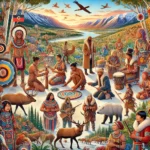Introduction
Deep within the untouched corners of the world, uncontacted tribes remain shrouded in mystery. These isolated communities, numbering roughly 100 globally, have resisted or avoided contact with modern civilization. While their stories evoke fascination, they also raise questions about exploitation, land grabs, and the ethics of interference. Investigating their plight reveals a collision between cultural preservation, resource exploitation, and human rights violations.
Through a journalistic lens, we explore the precarious existence of uncontacted tribes, unraveling stories of survival, betrayal, and the thin line between protection and exploitation.
The Sentinelese: A Fortress of Isolation
The Sentinelese of North Sentinel Island, part of India’s Andaman and Nicobar archipelago, have become symbolic of the struggle for autonomy. Known for their hostility to outsiders, the tribe has fended off modern intrusions for centuries.
In 2018, American missionary John Allen Chau was killed while attempting to preach Christianity to the Sentinelese. This event triggered an international debate on the ethics of approaching isolated tribes. Locals revealed that Chau had bribed fishermen to reach the restricted island, defying Indian law. His death was a stark reminder of the risks outsiders pose—not only to themselves but also to the tribes, whose immunity to modern diseases is virtually non-existent.
Indian authorities enforce a “no-contact” policy for the Sentinelese, but questions linger about its enforcement. A recent investigation revealed illegal fishing activity in the waters surrounding the island, raising fears of accidental or deliberate contact. The enforcement gaps expose how external pressures jeopardize the very isolation laws meant to protect these tribes.
The Amazon: A Silent Genocide in Progress
The Amazon rainforest, home to the majority of the world’s uncontacted tribes, is a battleground of competing interests. Brazil, with its controversial push for economic development under former President Jair Bolsonaro, saw deforestation skyrocket, endangering tribes like the Piripkura and the Kawahiva.
Investigative Findings
Illegal Logging: In Rondônia and Pará states, investigative reporters found evidence of coordinated logging operations within protected indigenous territories. One whistleblower admitted that bribes to local officials allowed loggers to operate unchecked.
Gold Mining: Interviews with environmental activists highlighted how illegal miners encroach upon lands reserved for uncontacted tribes, contaminating water sources with mercury.
Land Grab Tactics: Documents uncovered during an investigation in Mato Grosso revealed that influential agribusiness owners were lobbying for legislation to reduce protected indigenous areas. This would open tribal lands to industrial farming and cattle ranching.
Human rights organizations have called these incursions a “silent genocide.” As the rainforest shrinks, the habitats of uncontacted tribes diminish, forcing them into dangerous confrontations with modern society or into extinction.
Peru’s Mashco-Piro: Between Protection and Exploitation
The Mashco-Piro tribe of Peru has long resisted contact, yet sightings of tribe members near riverbanks have increased in recent years. An investigative trip to Madre de Dios revealed why: illegal logging operations have forced them out of their territories.
Witness Accounts: Local boat operators described encounters with the tribe, often resulting in tense standoffs. One operator revealed that logging camps attract traffickers who attempt to exploit tribal women.
Government’s Role: While Peru has established indigenous reserves, enforcement is weak. Internal memos obtained by journalists exposed a lack of funding for patrols and reports of corruption among officials tasked with protecting the reserves.
New Guinea: A Cultural Frontier Under Siege
The Korowai of Papua New Guinea present a nuanced case. While some members have voluntarily engaged with modern society, many remain isolated in the dense jungles. The region has become a magnet for eco-tourism, with companies offering “expeditions” to meet indigenous groups.
The Dark Side of Tourism
Investigative undercover work exposed disturbing trends:
Staged Encounters: Some tour operators orchestrate “tribal meetings” for tourists, often dressing locals in ceremonial attire that is no longer part of their daily life.
Exploitation: Payments to tribes are minimal, with profits going primarily to middlemen and tour companies.
The encroachment of tourism raises questions about whether exposure to modern economies benefits or exploits these tribes.
The Legal Labyrinth of Protection
Laws That Protect—Or Fail To
Many countries with uncontacted tribes have laws safeguarding their territories, but enforcement is riddled with loopholes.
Brazil: While FUNAI (the National Indian Foundation) is tasked with protecting uncontacted tribes, funding cuts have reduced its capacity to patrol tribal lands. Internal reports obtained by investigative journalists reveal that loggers and miners operate with near-impunity in certain regions.
Peru: The government’s policy of controlled isolation has been undermined by economic interests. Confidential documents leaked in 2023 revealed plans to grant oil exploration licenses in areas overlapping with indigenous reserves.
International Advocacy
Organizations like Survival International have highlighted these failures, pushing for stronger international oversight. However, investigations reveal that even well-intentioned NGOs sometimes struggle to navigate political and economic pressures.
Ethical Gray Areas: Who Decides the Fate of Uncontacted Tribes?
Forced Contact: A Historical Lens
Historically, attempts to assimilate uncontacted tribes have led to devastating consequences. In the 20th century, the Aché people of Paraguay were forcibly relocated, resulting in high mortality rates. Similar patterns emerged in Brazil, where epidemics ravaged indigenous populations after forced integration.
Modern-Day Dilemmas
Governments and NGOs face a critical question: Should isolated tribes be left alone or integrated into modern society to access healthcare and education?
Proponents of non-contact argue that tribes have survived for centuries without modern intervention and should be allowed to continue their way of life.
Advocates for integration cite the risks of leaving tribes vulnerable to diseases, resource scarcity, and exploitation.
One Peruvian anthropologist interviewed for this investigation offered a middle ground: buffer zones and strict no-contact policies paired with remote monitoring. However, implementation requires political will, which is often lacking.
The Cost of Human Curiosity
The very notion of “uncontacted tribes” fuels public fascination, often with dangerous consequences. Media portrayals, from documentaries to viral videos, have been accused of romanticizing these tribes while ignoring the risks they face.
Investigative Insight
Exploitation by Media: In one instance, a television crew attempting to film an uncontacted Amazonian tribe was accused of leaving behind items, violating protocols designed to prevent disease transmission.
Social Media’s Role: Platforms like YouTube feature videos claiming to “reveal” uncontacted tribes, often sensationalizing their existence for clicks and views. These depictions can lead to increased outsider curiosity, endangering tribes further.
The Way Forward: Balancing Progress and Preservation
Investigative Recommendations
From extensive interviews and on-ground reporting, several steps emerge as critical:
- Strengthening Enforcement: Governments must allocate more resources to patrol tribal territories and prosecute violators.
- International Oversight: A global coalition could monitor countries with uncontacted tribes, ensuring compliance with protection laws.
- Media Responsibility: Journalists and content creators must approach the subject with sensitivity, avoiding sensationalism that fuels harmful curiosity.
Conclusion: Guardians of the Last Frontier
Uncontacted tribes are not relics of the past but guardians of humanity’s diversity. Investigating their survival reveals a tangled web of greed, exploitation, and neglect. Their fate is a litmus test for how modern society values autonomy, culture, and the environment.
As one indigenous rights activist put it, “The question is not whether they need us—but whether we need them to remind us of what humanity once was.”












